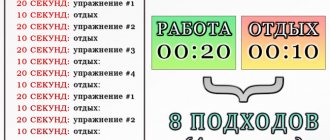Interest in long and rather boring cardio workouts is gradually fading away. Monotonous exercises for losing weight and staying in shape are being replaced by a relatively new trend in fitness - high-interval training.
The Tabata protocol training system, created by the Japanese doctor Izumi Tabata, has undergone a number of scientific tests. As a result, it was possible to establish that interval training has a stronger effect on aerobic and anaerobic performance of the body. A special set of exercises, the goal of which is to do as many specific movements as possible in a minimum period of time, helps burn fat and strengthen muscles. These results were obtained by specialists from the National Institute of Fitness and Sports in Tokyo directly under the guidance of the author of the Tabata training method.
The history of the appearance of training using the Tabata method
Doctor of Science and physiologist Izumi Tabata in 1996 began developing a new training system to increase endurance in athletes. The experiment lasted 6 weeks. Two groups of athletes took part in it: one trained for 1 hour 5 days a week, and the other trained 4 times a week, but only for 4 minutes.
It's time to compare the results of this experiment. Athletes from the first group showed an improvement in aerobic performance, which indicates a positive effect on the heart and blood vessels. But at the same time, the volume and strength of muscle tissue remained unchanged. There was no muscle gain. The level of endurance also remained at the original level.
And participants from the second group showed improvements in both aerobic and anaerobic performance. But the athletes trained less often and spent less time on it. And the results were many times better than those of athletes from the other group.
What is Tabata?
Tabata is a 4-minute high-intensity interval training (HIIT) that consists of 2 intervals: 20 seconds sprint and 10 seconds rest . This cycle is repeated 8 times , and thus the workout lasts only 4 minutes. According to scientists from the University of Wisconsin and recent research conducted at the American College of Sports Medicine conference, you can burn about 14 calories per minute , which improves aerobic and anaerobic endurance in even more than an hour of light cardio. [6]
A short example of the Tabata formula:
20 second sprint
10 rest
Total time = 4 minutes [3]
What do you need for Tabata?
Tabata is performed with maximum effort and intensity, which must be maintained for 20 seconds (followed by rest and recovery time). Repeat this set a total of 8 times to complete the 4-minute workout . You can train without any fitness accessories and use only your own weight. For more intensity, try jumping rope, jumping jacks, or cardio equipment. Show your imagination!
All you need for Tabata is a timer or stopwatch . You can also use a tabata stopwatch on your computer, a regular timer on your smartphone , or download an app. In addition to saving time, such workouts help burn a large number of calories , which the body will burn even throughout the day. If you're ready for maximum intensity - and willing to give it your all for a short time - Tabata is what you need.
“By resting only half the duration of intense exercise (2:1 training to rest ratio), the body is forced to work without full recovery. In simple words: at a certain time between sets 6 and 8, you reach the point of maximum oxygen consumption, and you will definitely not be able to breathe enough.”
Tabata training rules
The results of an experiment conducted by Izumi Tabata in 1996 amazed even the most devoted fans of cardio training. It turned out that high-interval training allows you to effectively burn fat and develop the overall endurance of the body. But there is no need to practice for an hour or more - just 4 minutes is enough.
The Tabata round has the following structure:
- 20 seconds of intense training;
- 10 seconds rest.
The duration of the Tabata training session is 4 minutes. It includes 8 rounds. Exercises are allowed to be alternated at your own discretion. The interval between rounds can be 1-2 minutes. Then the total duration of the lesson will be 12-16 minutes.
The main rule of effective Tabata fitness training is to train at your maximum effort. Even if you are doing the exercises of the last round, you cannot slow down and spare strength. Otherwise, the training will be considered ineffective.
To maintain time intervals, it is more convenient to use special timers so as not to miss the end of a short rest period. Such programs can be downloaded and installed on any device. To maintain high performance, it is important to choose suitable sportswear that is made of high-quality fabrics and does not hinder movement.
Benefits of Tabata
Tabata training is very popular among those who want to lose weight, as well as among those who do not want to spend too much time on fitness. What are the benefits of short, high-intensity interval training?
- Burn more calories than a regular cardio workout: Because the exercises are performed at maximum speed, your heart rate skyrockets and stays high throughout the session.
- “Afterburn effect”: the result of intense work that directly follows from the first point - even after training, the body continues to burn calories, ridding the body of excess weight.
- Aerobic and anaerobic performance improves: that is, thanks to Tabata you not only increase the body's endurance, but also develop muscle strength.
- Versatility: you can practice Tabata at home, on the street, as well as in fitness rooms.
- Simplicity: Tabata training does not require special equipment - at the initial stages, your own body weight is enough, the exercises themselves are simple and known to everyone since school physical education.
- Quick workouts - quick results: you spend only a few minutes a day, but the results of 3 - 4 Tabata workouts per week will be noticeable after a couple of weeks of regular exercise.
In addition, like any other workout, Tabata helps relieve tension and get rid of depression, as well as significantly reduce the risk of developing diabetes.
What exercises can you do?
The Tabata protocol includes different exercises. Choose those that suit your fitness level.
The main exercises:
- sprint;
- punches and kicks;
- lunges;
- push ups;
- jumping out;
- squats;
- rowing on a simulator;
- kettlebell swings;
- lifting the body;
- swimming.
It is recommended to choose exercises that involve several muscle groups at once. You can practice in small groups or alone, including the use of instructional videos. Before training, it is recommended to familiarize yourself in detail with what Tabata is, the features of using this technique in fitness and its role in the overall health of the body.
Benefit
Tabata is a modern and effective exercise that will appeal to lovers of short but productive workouts. When choosing this gymnastics, you should pay attention to the benefits that come after performing the elements:
- Possibility to choose gymnastic exercises to your taste.
Tabata is a multi-component phenomenon, so here you can choose those types of elements that suit your taste and coincide with your capabilities. It is not forbidden to create your own complex, which together will allow you to quickly achieve your goal.
- Availability of gymnastics for home performance.
To lose weight, tone up your figure and get a boost of energy, you don’t have to train under the guidance of a fitness instructor. This nuance is especially relevant if this is not possible. It is enough to choose a set of exercises to create the necessary shape and get a boost of energy.
- Strengthening various muscle groups.
While performing gymnastics, an important process occurs - muscles are strengthened. As a result of the intensification of their activities, volumes decrease. Tabata allows you to create the proportions that are necessary.
- Benefits for the heart.
Tabata is an excellent cardio workout option that helps strengthen the cardiovascular system. During gymnastics, blood circulation is activated and blood vessels are actively stimulated. As a result, the athlete’s well-being improves.
- Rapid consumption of fat reserves.
Tabata is good because in the process of training there is an active depletion of fat deposits. The system is designed in such a way that even after stopping training, active breakdown of fats in the body occurs.
- There is no need to buy uniforms and exercise equipment.
Tabata is a type of fitness that can be performed even in regular sportswear. Here, unlike martial arts, there is no need to purchase a special suit. This rule applies to equipment as well. All it takes is dedication and a desire to act.
- Relaxed atmosphere.
You can perform Tabata elements to cheerful and inspiring music, which gives a charge of vivacity and positivity.
- Increased endurance levels.
People who regularly practice Tabata are noticeably different from those who ignore training. These athletes become strong and resilient. And not only physically, but also psychologically.
- Minimum time spent on training.
To achieve optimal results, you need to adhere to a simple and feasible exercise schedule - it is enough to exercise only 3 times a week for 4 minutes. And soon the fat deposits will disappear, and the figure will acquire an attractive shape.
Adherents of a healthy lifestyle who prefer Tabata will be able to evaluate the results within a month. This is a relatively short period of time to get attractive shapes and improve your well-being.
Warm-up as a prevention of accidental injuries
Little experience in sports pushes people to act rashly. Some people overestimate the capabilities of their body, ignore the anatomical features of the structure of muscles, ligaments and the entire musculoskeletal system, but strive to achieve their goal in a short time. A common mistake is not warming up. If you start intense training from a resting state, injuries cannot be avoided.
Be sure to warm up before each session. Jumping rope, running in place or on a treadmill are suitable. Be sure to “warm up” your joints with circular movements, bending, and smooth rotation of the limbs. You should spend at least 7-10 minutes warming up.
Core exercises for Tabata training
When it comes to the human body, the core muscles are perhaps the most important muscle group.
Perform each exercise for 20 seconds at high intensity and rest for 10 seconds. Continue with the exercise for 4 minutes (alternating between intensity and rest), then move on to the next one.
"Scissors"
Lie on your back and place your palms under your thighs. Your back should be completely pressed to the floor. Slowly lift both legs off the floor, spreading them apart. Start pressing them together and then spreading them apart (as in the photo). Make sure your legs are completely straight.
Plank Variation
Assume a plank position on your forearms. Forearms are on the floor. Elbows are directly under the shoulders. Straighten one arm with your palm flat on the floor, then do the same with the other arm. Now you are in a push-up position. Slowly lower the forearm of one hand to the floor, then the other. Now start with the other hand. Avoid rocking from side to side. The back is completely straight.
Lying leg raises
Lie on your back with your hands under your hips and your legs straight and slightly off the floor. Bend them at the knees, pulling your knees towards your chest, and then straighten them, lifting them up (heels pointing towards the ceiling). Tighten your abs and lower your legs back to the starting position before starting the next rep.
"Climber"
Get into a plank position. Begin to bend your right knee, pulling it toward your chest. Return your knee to the starting position and do the same with your left knee.
Russian twist
Sit on the mat, holding one kettlebell in both hands. Keep it at waist level. Bend your knees. Lean back. Keep your lower body still. Rotate to the right as you try to lower the kettlebell to the floor. Then turn to the left and lower the weight to the floor. Continue to rotate sideways with the kettlebell.
How is Tabata different from cardio training?
Cardio training occurs with the active participation of oxygen. Such exercises are called aerobic. High-intensity Tabata training causes the body to suffer from oxygen deficiency, puts it into anaerobic mode, which takes a lot of energy and immediately switches to burning fat.
It is impossible to train for a long time in this mode. But to achieve the desired result, only 8 rounds of Tabata are enough. As a result, you get not only active fat burning, but also strengthening and muscle growth, effective training of the heart and blood vessels. Tabata training has a positive effect on endurance, as it forces the body to work with all its strength and teaches it to adapt to similar stress factors in the future.
Tabata Workout Plan
Training Plan A (Monday Plan)
• Mountain climber (maximum number of repetitions for 20 seconds, 10 seconds rest)
• Lying leg raise (maximum number of repetitions for 20 seconds, 10 seconds rest)
• Burpees (maximum number of repetitions for 20 seconds, 10 seconds rest)
• Classic squat with hands behind head (maximum number of repetitions for 20 seconds, 10 seconds rest)
• Climber (max reps for 20 seconds, 10 seconds rest)
• Lying leg raises (maximum number of repetitions for 20 seconds, 10 seconds rest)
• Burpees (maximum number of repetitions for 20 seconds, 10 seconds rest)
• Classic squat with hands behind head (maximum number of repetitions for 20 seconds, 10 seconds rest)
Training Plan B (Wednesday Scheme)
• Sprint – max reps in 20 seconds followed by 10 seconds rest (place cones 1.5m apart and sprint in between)
• Throwing the ball on the floor – (maximum number of repetitions for 20 seconds, 10 seconds rest)
• Classic squat with hands behind head (maximum number of repetitions for 20 seconds, 10 seconds rest)
• Punching bag exercise – (maximum number of repetitions for 20 seconds, 10 seconds rest)
• Sprint – max reps in 20 seconds followed by 10 seconds rest (place cones 1.5m apart and sprint in between)
• Throwing the ball on the floor – (maximum number of repetitions for 20 seconds, 10 seconds rest)
• Classic squat with hands behind head (maximum number of repetitions for 20 seconds, 10 seconds rest)
• Punching bag exercise – (maximum number of repetitions for 20 seconds, 10 seconds rest)
If you like to work out in a group, find out if your favorite gym offers Tabata. Or get inspired by workouts on YouTube and do Tabata at home.
Who is Tabata training suitable for?
High interval training is suitable for trained people who regularly exercise and do not have serious problems with the heart or joints.
Tabata solves the following problems and helps achieve specific goals:
- intensive fat burning in a short period of time;
- increasing overall endurance;
- strengthening the heart muscle;
- acceleration of metabolic and hormonal processes in the body;
- the opportunity to get into good physical shape by spending 10-15 minutes a day doing exercises;
- noticeable increase in strength indicators;
- acceleration of muscle tissue growth, the ability to move to a more complex level of training in strength sports.
The technique requires composure and certain physical preparation. First make sure that there are no direct medical contraindications to intense exercise.
Pros and cons of Tabata training
Yulia Shum, co-founder and head coach of the EBSH sports hub network:
“Pros of Tabata training:
• develop endurance; • allow you to work out almost all muscle groups; • high calorie expenditure during training, which promotes weight loss; • improve coordination abilities; • stimulate the body to accelerate adaptation, help overcome the plateau effect (relative to weight and training progress); • do not require much time to complete.
The main disadvantages of Tabata training:
• high intensity training; • not suitable for beginners, at least an average level of physical fitness is required; • heavy load on joints; • not suitable for people with a lot of excess weight, high blood pressure, dizziness, heart failure, atherosclerosis and, of course, pregnant women.
For whom Tabata training is contraindicated?
The Tabata technique is not for beginners in the sport. It is forbidden to immediately put high stress on the body. This can lead to injuries, exacerbation of chronic diseases, and surges in blood pressure. Tabata high interval training is suitable for those who regularly engage in cardio training or strength sports for at least 2-3 months.
The technique has the following contraindications:
- acute and chronic pathologies of the heart and blood vessels;
- injuries, inflammatory and destructive processes in joints;
- excess weight, in which you cannot perform exercises due to excessive stress on the joints;
- following a low-carbohydrate diet, which is accompanied by a lack of strength and energy;
- pregnancy;
- anemia, physical weakness, dizziness;
- instability of blood pressure.
Training is carried out when you are feeling well. If you have headaches, high blood pressure, or acute pain in the joints, it is better not to exercise for a while. But after high-intensity training, muscle pain occurs in the first months. They can be quite intense, especially for beginners. The reason for their appearance is the body’s natural reaction to the destruction of muscle fibers.
As a result, protein fragments are formed that absorb protective cells and release products that cause short-term pain. It is important to be able to distinguish pathological pain syndrome from physiological one. If you have any doubts, you should visit a traumatologist or orthopedist, conduct X-ray diagnostics or a modern MRI examination.
Temporary contraindications
The desire to go towards the intended goal, not paying attention to certain signals from the body, can end in failure. There are temporary conditions in which exercise is contraindicated. Otherwise, you can harm your health.
Tabata training is not carried out for the following conditions and disorders:
- increased body temperature;
- exacerbation of any chronic pathologies;
- headache;
- menstruation;
- recent injuries to the musculoskeletal system;
- severe fatigue;
- dizziness;
- increase or excessive decrease in blood pressure;
- decrease in hemoglobin;
- problems with coordination of movements;
- drowsiness.
High interval training can cause dizziness, especially in people with poor coordination. If you are not feeling well, reschedule the class for another day. Before training, you can measure your blood pressure and pulse. Sometimes abnormalities in the functioning of the heart and blood vessels do not manifest themselves at all, but can cause complications during intense exercise.
Tabata training provides maximum stress on different muscle groups, joints and all body systems. High-intensity training is not for everyone. For people without certain sports training, it can undermine their health.
The optimal age for using the technique is 25-40 years. If you already have joint problems, you should not choose Tabata. This is not a physical therapy method. Intense, high-speed exercise is not suitable for damaged joints with active degenerative changes.
Blog Fitparade.ru
Tabata training scheme.
A classic Tabata workout only lasts
4 minutes
, but it will probably be one of the longest 4 minutes of your life. The program is implemented as follows:
1. Intense load for 20 seconds.
2. Rest - 10 seconds. Total 8 rounds.
You can incorporate almost any exercise you want into your Tabata workout as long as it targets large muscle groups. Whatever exercise you choose, Tabata training will immediately increase your metabolism and heart rate. Because these exercises are performed at such a high intensity, your body will have to work much harder to keep up. This will get your heart pumping and speed up your metabolism, which is especially beneficial especially if you want to burn fat. Your metabolism will remain at this high level not only during the workout, but also after it.
Tabata Protocol.
In Dr. Tabata's study, participants used only a stationary bike for 4 minutes of exercise. So the protocol or "base" for this type of workout is a 5-10 minute warm-up followed by 8 sets of 20 seconds max/10 seconds rest. This protocol now serves as the basis for updating, and the options are becoming unlimited so that the training program can be modified for different muscle groups. Suitable exercises are squats, push-ups. A combination of two or more exercises can be done, and different exercises can be chosen for each series for the best overall effect. For those more advanced, you can do two, three or more four-minute sessions with a few minutes of rest in between.
What makes Tabata better than other workouts?
The fact that your metabolism will remain fast not only during exercise, but also after it, meaning that your body will burn fat even when you are not doing anything. When doing other forms of moderate cardio, you will have to wait until your body is warmed up to start burning fat. Once you stop doing cardio, your body stops burning calories. But not after Tabata training. Tabata training puts the body directly into fat burning mode during the first cycle and maintains it for several hours after that.
The last thing you want to do during a Tabata workout is extract energy from your muscle tissue. With short periods of exercise, muscle tissue will not be damaged as would happen during long-term cardio training. The Tabata method focuses on the muscles, which tell your body that more muscle tissue is needed and the exercise time is not enough to break down muscle protein as an energy source.
No matter how busy you are, spending four minutes on this high-intensity workout is enough. Plus, you don't have to go to the gym to get good results. All you need is your own body weight or commercially available dumbbells.
Additionally, Tabata training increases anaerobic capacity (the maximum amount of energy that can be produced by our body in the absence of oxygen) and aerobic capacity (the maximum oxygen consumption). According to recent studies, participants who undergo Tabata training increase their aerobic capacity by more than 14% and anaerobic capacity by 28%. The result is more energy and stamina, and a greater degree of resilience to long-term stress and effort.
This makes Tabata a great way to train quickly if you're short on time, want to change up your routine, or improve your endurance and speed.
Frequency of classes
The frequency of high-intensity training depends on your main goals. Those who want to lose weight are recommended to perform 8 rounds with a break of no more than 1-2 minutes - 3-4 times a week. Exercising daily is not recommended, as this leads to signs of overtraining and can reduce strength indicators.
To maintain physical fitness, Tabata training is recommended to be combined with strength training. Try doing high interval exercises 5-10 minutes after your main workout instead of standard cardio. This will improve strength performance and accelerate muscle gain.
Exercise Variations
In 4 min. It is supposed to do different activity options:
- all 8 exercises are aimed at one muscle group;
- alternately performing 2 strength and 2 cardio tasks;
- all approaches include the same type of load;
- 4 exercises for one muscle zone and 4 for another.
It is recommended to create a schedule and alternate cardio with strength training or change tasks every day.
Lunges and jumps
Cardio exercise is the best type of physical activity for Tabata training. The following options are envisaged:
- mill;
- forward or diagonal lunges;
- jumping rope or sideways.
Such exercises will help increase your heart rate and work your abdominal, chest, and thigh muscles.
Cardio loads
Cardio tasks are classified as fat burning; they also actively train the muscles of the abdomen and lower extremities. People who are poorly physically prepared, as well as those with a large body weight, need to protect their knees with an elastic bandage. A good exercise is skiing or jogging in place with raising your knee joints or heels.
Butt training
Working out the gluteal muscles involves performing different types of squats (deep with lunges, turns, jumps or leg raises). Such physical activity will help tighten and make your buttocks attractive.
Exercises for the abs
It is recommended to include tasks to work all the abdominal muscles in Tabata training. These are different types of planks (with rotation, shoulder touch and leg curl). To increase the effectiveness of training, it is necessary to combine physical activity with proper nutrition.










